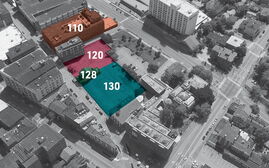
Mixed preview of 2023 offered at MEREDA conference
 File photo / Alexis Wells
MEREDA hosted more than 750 people at its 2023 Real Estate Forecast Conference, held at the Cross Insurance Center..
File photo / Alexis Wells
MEREDA hosted more than 750 people at its 2023 Real Estate Forecast Conference, held at the Cross Insurance Center..
MEREDA’s 2023 Real Estate Forecast Conference offered a mixed look at the real estate market for the year. Coming off two red-hot years, the real estate forecast becomes a bit more nuanced going into this year. Construction companies and brokers are busy, projects are underway, deals are still being made, but higher interest rates, tight inventory across the real estate spectrum, fluctuating construction costs and uncertainty in the economy all bring a measure of caution this year.
This year’s conference, held at the Cross Insurance Center in Portland on Jan. 26, had a crowd of 750-plus attendees, who were there for the showcase and more than a dozen presentations. “I love seeing you all here,” MEREDA President Craig Young, a partner and broker at the Boulos Co., said in his opening remarks. “There’s just a buzz in the air.”
Single-family market expected to level off
After two crazy years characterized by bidding wars and escalating home prices, the housing boom has already peaked and this year is expected to continue to level off.
Dava Davin, principal at Portside Real Estate and presenter of the sector analysis for the single-family home market, said Maine’s median home price peaked in June 2022, at $360,825, driven by the pandemic-related buying frenzy. Just five years ago, the median home price was $200,000.
She said her office started to see showings taper off by August, and with interest rates spiking above 7% by late year the market cooled noticeably.
What didn’t cool off were prices. Sellers, she said, are still seeking top dollar.
Going into the year, she expects strong demand in towns that have seen buying action — much of it in southern Maine, where the median home price is $475,000 — and much of it will be centered around “cream puff listings” that are move-in ready.
By contrast, with houses that need work or are less desirable, brokers are seeing listings expire.
“If it’s going to sell, it’s going to sell fast,” she said. “Other places are sitting.”
For this year, she expects to see prices level off. Demand will be steady because there’s too little inventory to satisfy the need for housing. She expects fewer transactions than the past two years. She also said there’s positive signs that interest rates may head back down into the 5% territory.
About 1 in 3 buyers are from out of state. Massachusetts buyers lead the charge, accounting for 8% of the overall market.
With the higher home prices, she said “many Mainers couldn’t afford the home they live in,” which means there are fewer people making lateral moves to other homes.
Where people used to move every seven years, that’s now every 10 years, she said.
Multifamily market still strong — and benefitting new cities
Portland has had a strong multifamily market in recent years, but the outlook is somewhat murky.
Brit Vitalius, owner of Vitalius Real Estate Group and the presenter of the multifamily home analysis, said rents in Portland at the high end are $3,300 to $3,500 a month. but the higher end of the market is slowing. The middle and lower market, from $1,200 to $3,000, is still tight.
On the development side, Vitalius said investors are still cautious after the passage of the Green New Deal, which makes it harder for new projects to be profitable.
He cited two major Portland projects that are underway that were both approved before the Green New Deal went into effect: Maine’s tallest building, 201 Federal St., a Redfern development that will have 263 rental units, and a Port Property apartment building in West Bayside, with 171 units.
Outlying markets have been the beneficiary, he said.
Saco-Biddeford saw the 2022 completion of the Lincoln, with 147 loft apartments going for $1,350 to $2,700 a month. Also in Saco-Biddeford, the Levee is expected to open this year, with 96 lofts renting for $1,835 to $2,800 a month.
Likewise, Lewiston and Auburn have seen an increase in interest. Last year, on the sale side, Vitalius said there were just 16 active listings, compared to 200 listings in 2008.
“Bad housing policies in Portland are driving people to other cities,” he said.
Bullish retail outlook
Peter Harrington, a partner with Malone Commercial Brokers, offered a bullish outlook for the Greater Portland retail market.
Dismissing concerns over the last year or two about retail being dead, Harington said, “I’m here to tell you … that’s simply not true.”
Out of 6.6 million square feet of retail space in Greater Portland tracked by his firm, close to 280,000 square feet, or 4.23%, is vacant.
Vacancy rates range from zero in Cape Elizabeth (albeit with only 34,735 square feet) to 16.3% in Westbrook, which Harrington attributed to the closure of a Shaw’s Supermarket across from Market Basket, “a tough competitor.”
But he said Westbrook remains strong for retail both downtown and at Rock Row, noting that “it’s all going very well out there.”
A call to action on housing
Greg Payne, a senior advisor on housing in the Governor’s Office of Policy Innovation and the Future and former development director Avesta Housing, built on what then-Maine House Speaker Ryan Fecteau touched on last year.
Payne noted that there’s still a large gap between the supply of housing units in Maine and demand, and that prices for rented and owned homes “are really, really high.”

But he also pointed to progress in some areas, including state legislation, to address emergency housing and homelessness; checks that are currently being processed for federal emergency rental assistance; and investment by the state to develop permanent affordable housing.
“The administration will remain focused on increasing supply,” he said.
Payne also said the administration would like to see more towns, organizations and companies get involved in efforts to boost the state’s housing supply, and that MaineHousing has created a technical assistance program via the Genesis Community Loan Fund to assist in that regard.
Elsewhere on the legislative front, Payne said a zoning reform law set to take effect this summer will give all Maine homeowners the right to add an accessory dwelling unit to their property and allow four units to be developed on residentially zoned land rather than just one.
“The administration is absolutely committed to making sure that LD 2003 is operationalized and put into effect,” he said.
Wrapping up with a call to action, Payne said, “Let us recommit to working together and acknowledge that a decent home is essential, and we will build it.”
Southern Maine industrial forecast: ‘Demand is there’
Southern Maine’s industrial market is healthy, competitive and strong, said Justin Lamontagne of the Dunham Group. But there’s limited supply, with the vacancy rate under 3%. That affects tenants, buyers and landlords.
With ongoing supply chain issues, there’s a trend in storage and warehousing as businesses store supplies just in case they need them, instead of ordering supplies “just in time.”
The demand for space among cannabis companies continues. Lamontagne said he’s seeing turnkey medicinal market cultivation spaces coming back onto the market. That leads to the question of what to do with industrial facilities that have been specifically built for cannabis, short of another cannabis business replacing previous users.
Construction costs are hampering deals.There have also been major delays in deliveries of supplies — basic components like fixtures and ductwork as well as materials. As a result, transaction activity was hampered by supply chain issues.
Concerning signals for the industrial sector include higher interest rates, inflation, labor issues and the possibility of a recession, he said. Inflation in particular raises negotiations with regard to setting lease renewals and rate increases.
Former office space could be a new entry in the industrial market, he said. Some are primed for industrial conversion — similar to big-box retail conversions. Office spaces on the ground level, with interior HVAC, plenty of parking, and even loading areas translate to low-impact light industrial.
Greater Bangor area forecast: A range of real estate demand
In Greater Bangor, industrial vacancy is tight, making it extremely difficult to find new spaces for tenants, said David Hughes of Epstein Commercial Real Estate.
Still, the area saw some industrial construction in 2022 and expects more in 2023.
Downtown Bangor is bolstered by a strong office market, more and more apartments and a strong group of restaurants and retail, he said.
Housing developments in downtown Bangor have been a “game changer,” he said.
The last couple of years have brought more and more people living in the downtown and downtown residential conversions of older buildings have picked up considerably, with 76 units under development or completed in the last year. Units have been leasing before they’re even completed, he said.
“People enjoy living and working downtown,” he said.
The coming year is expected to be challenging due to a relatively static inventory in industrial and office space, continued low vacancies, higher interest rates and construction costs, he said.
Southern Maine office forecast: ‘Steady’
Nate Stevens, a partner and designated broker with the Boulos Co., said downtown Portland rates have been increasing in demand. The city saw nine significant transactions downtown, eight to nine of them being subleases and downsizes. A few of these significant transactions downtown include 100 Middle St., 25 Pearl St., Two Portland Square and 120 Exchange St.
“Demand will stay low but steady, a clearer market outlook, more time to look at the post-pandemic market, downtown vacancy rates will increase in Class B, suburban vacancy rates hold steady, and more opportunities for tenants to absorb some sublease spaces,” said Stevens.














0 Comments